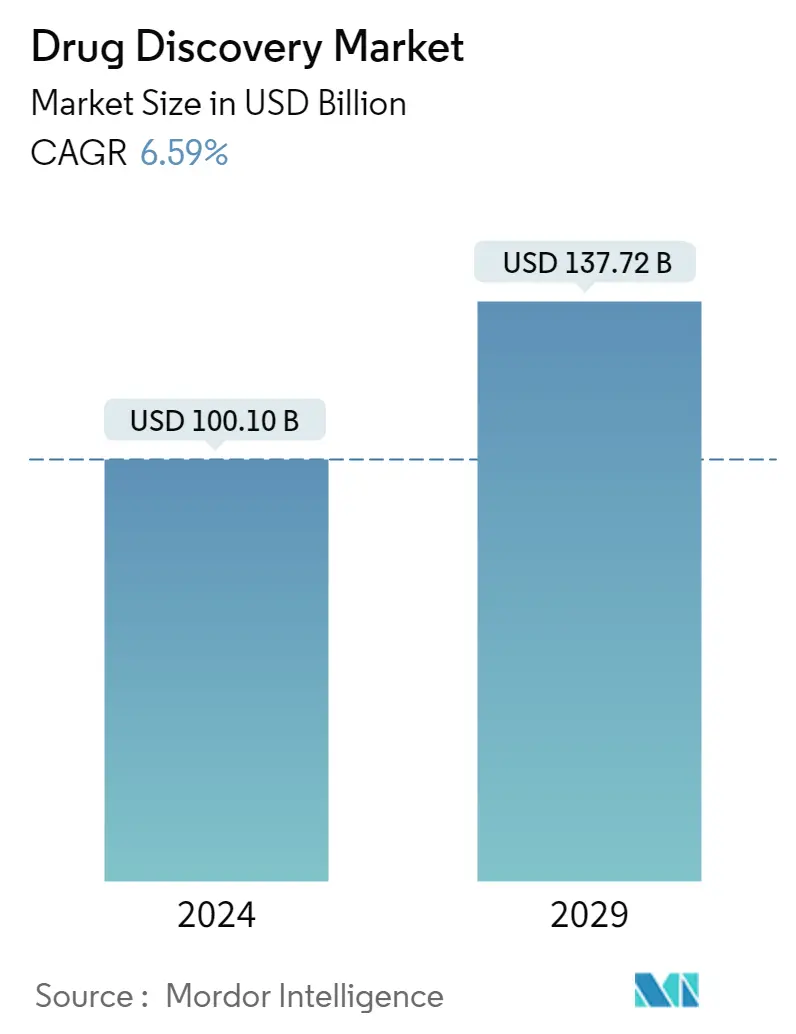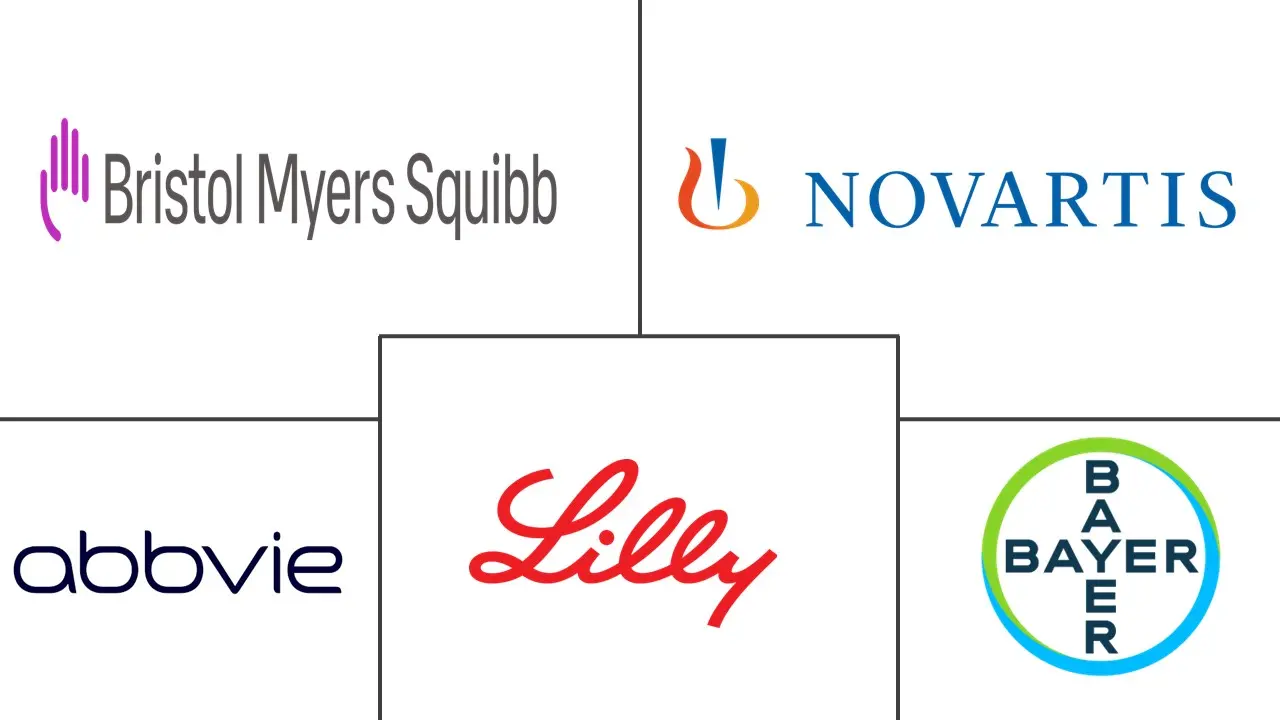Market Size of Drug Discovery Industry

| Study Period | 2020 - 2029 |
| Market Size (2024) | USD 100.10 Billion |
| Market Size (2029) | USD 137.72 Billion |
| CAGR (2024 - 2029) | 6.59 % |
| Fastest Growing Market | Asia Pacific |
| Largest Market | North America |
Major Players
*Disclaimer: Major Players sorted in no particular order |
Drug Discovery Market Analysis
The Drug Discovery Market size is estimated at USD 100.10 billion in 2024, and is expected to reach USD 137.72 billion by 2029, growing at a CAGR of 6.59% during the forecast period (2024-2029).
Amid the COVID-19 pandemic, the health systems of various countries rapidly invested in research and development to combat the virus. Potential compounds were screened from the CHEMBL, ZINC, FDA-approved drugs, and molecules under clinical trials. Research groups worldwide have identified drugs for the treatment of COVID-19 by screening both novel and existing drugs for their ability to alleviate symptoms and stop viral replication. Thus, the drug discovery market was positively impacted due to the urge to find a cure for COVID-19. Furthermore, post the pandemic, there is a rise in investments in different modalities of drug development, such as gene and cell therapies for both COVID-19 diseases and other novel diseases, which is expected to impact the market's growth as per the analysis positively. Furthermore, the research for developing antiviral drugs for COVID-19 is still in progress. For instance, in May 2022, the National Institute of Allergy and Infectious Diseases (NIAID) awarded approximately USD 577 million to establish nine Antiviral Drug Discovery (AViDD) Centers for Pathogens of Pandemic Concern. The AViDD centers will carry out creative, interdisciplinary research to create candidate COVID-19 antivirals, particularly those that can be used outside of a hospital setting, as well as antivirals that target particular viral families with a high potential to trigger a pandemic in the future. Such grants are expected to drive the drug discovery market's growth post-pandemic.
The propelling factors for the growth of the drug discovery market include the rising burden of a wide range of diseases (such as cardiovascular and CNS-related disorders), rising healthcare expenditure, and the upcoming patent expiration of blockbuster drugs.
Cardiovascular diseases, infectious diseases, diabetes, and kidney-related complications are highly prevalent worldwide. According to key facts about cardiovascular diseases (CVDs) published by the WHO in June 2021, CVDs are the leading cause of death globally, representing around 32% of all global deaths. CVD remains the leading cause of death and disability and remains highly complicated, costly, and burdensome. Moreover, new strategies are required to streamline and reduce the costs of clinical trials while placing greater importance on the patient experience and voice. Thus, the increasing burden of a diverse range of diseases among all age groups and its burden globally drive the demand for drug discovery and its market.
Furthermore, there has been an upsurge in the usage of advanced technologies, such as high-throughput process development, bioinformatics, and combinatorial chemistry, for better drug candidate identification. Drug discovery has evolved significantly with emerging technologies, helping the process become more refined, accurate, and time-efficient. The adoption of artificial intelligence systems in disease diagnostics and treatment design is growing, and this is expected to witness robust growth in the coming years. For instance, in March 2020, Existencia, an AI-based drug discovery company, entered a collaborative agreement with Diamond Light Source and Scripps Research to identify COVID-19 antiviral therapies. Thus, these factors are anticipated to contribute to the market's growth over the forecast period.
However, the huge capital investment, low-profit margins, and stringent drug discovery regulations are expected to hinder the market growth.
Drug Discovery Industry Segmentation
As per the scope of the report, drug discovery is a process aimed at identifying a compound that is therapeutically useful in treating and curing diseases. Typically, a drug discovery effort addresses a biological target that has been shown to play a role in the development of the disease or starts from a molecule with interesting biological activities. In the recent past, drug discovery has evolved significantly with emerging technologies, helping the process become more refined, accurate, and time-consuming.
The drug discovery market is segmented by drug type (small molecule drugs and biologic drugs), technology (high throughput screening, pharmacogenomics, combinatorial chemistry, nanotechnology, and other technologies), end user (pharmaceutical companies, contract research organizations (CROs), and other end users), and geography (North America, Europe, Asia-Pacific, Middle East and Africa, and South America). The report offers market forecasts and revenues in terms of value in USD million for the above segments.
| Drug Type | |
| Small Molecule Drugs | |
| Biologic Drugs |
| Technology | |
| High Throughput Screening | |
| Pharmacogenomics | |
| Combinatorial Chemistry | |
| Nanotechnology | |
| Other Technologies |
| End User | |
| Pharmaceutical Companies | |
| Contract Research Organizations (CROs) | |
| Other End Users |
| Geography | ||||||||
| ||||||||
| ||||||||
| ||||||||
| ||||||||
|
Drug Discovery Market Size Summary
The drug discovery market is poised for significant growth over the forecast period, driven by increased investments in research and development, particularly in response to the COVID-19 pandemic. The urgency to develop effective treatments for COVID-19 led to a surge in the screening of both novel and existing drugs, positively impacting the market. This momentum has continued post-pandemic, with a focus on advanced modalities such as gene and cell therapies. The ongoing research and development efforts, supported by substantial funding from organizations like the National Institute of Allergy and Infectious Diseases, are expected to further propel market growth. The rising prevalence of diseases such as cardiovascular and CNS-related disorders, coupled with the impending patent expirations of blockbuster drugs, is also contributing to the market's expansion. The adoption of advanced technologies, including high-throughput process development and artificial intelligence, is enhancing the efficiency and accuracy of drug discovery processes, further driving market growth.
The biologics segment is experiencing rapid expansion due to its specific advantages, such as target specificity and fewer side effects, which have led to increased demand. The pandemic accelerated the development and adoption of biologics, with significant collaborations and partnerships among major biotech firms to advance biologics drug discovery. Regulatory approvals for biologics are on the rise, further propelling this segment's growth. North America, with its substantial investment in pharmaceutical and biologics R&D, is a key region driving market growth, supported by a robust healthcare infrastructure and technological advancements in drug discovery. The competitive landscape of the drug discovery market is characterized by the presence of major players who are leveraging innovative strategies and technologies to expedite the development of novel drug molecules. These factors collectively indicate a promising growth trajectory for the drug discovery market in the coming years.
Drug Discovery Market Size - Table of Contents
-
1. MARKET DYNAMICS
-
1.1 Market Overview
-
1.2 Market Drivers
-
1.2.1 Rising Burden of Various Chronic Diseases
-
1.2.2 Increasing R&D Expenditure and Investment in the Development of Novel Drug Molecules
-
-
1.3 Market Restraints
-
1.3.1 Huge Capital Investment with Low Profit Margins
-
1.3.2 Stringent Government Regulations
-
-
1.4 Porter's Five Forces Analysis
-
1.4.1 Threat of New Entrants
-
1.4.2 Bargaining Power of Buyers/Consumers
-
1.4.3 Bargaining Power of Suppliers
-
1.4.4 Threat of Substitute Products
-
1.4.5 Intensity of Competitive Rivalry
-
-
-
2. MARKET SEGMENTATION (Market Size by Value - USD Million)
-
2.1 Drug Type
-
2.1.1 Small Molecule Drugs
-
2.1.2 Biologic Drugs
-
-
2.2 Technology
-
2.2.1 High Throughput Screening
-
2.2.2 Pharmacogenomics
-
2.2.3 Combinatorial Chemistry
-
2.2.4 Nanotechnology
-
2.2.5 Other Technologies
-
-
2.3 End User
-
2.3.1 Pharmaceutical Companies
-
2.3.2 Contract Research Organizations (CROs)
-
2.3.3 Other End Users
-
-
2.4 Geography
-
2.4.1 North America
-
2.4.1.1 United States
-
2.4.1.2 Canada
-
2.4.1.3 Mexico
-
-
2.4.2 Europe
-
2.4.2.1 United Kingdom
-
2.4.2.2 Germany
-
2.4.2.3 France
-
2.4.2.4 Italy
-
2.4.2.5 Spain
-
2.4.2.6 Rest of Europe
-
-
2.4.3 Asia-Pacific
-
2.4.3.1 China
-
2.4.3.2 Japan
-
2.4.3.3 India
-
2.4.3.4 Australia
-
2.4.3.5 South Korea
-
2.4.3.6 Rest of Asia-Pacific
-
-
2.4.4 Middle East and Africa
-
2.4.4.1 GCC
-
2.4.4.2 South Africa
-
2.4.4.3 Rest of Middle East and Africa
-
-
2.4.5 South America
-
2.4.5.1 Brazil
-
2.4.5.2 Argentina
-
2.4.5.3 Rest of South America
-
-
-
Drug Discovery Market Size FAQs
How big is the Drug Discovery Market?
The Drug Discovery Market size is expected to reach USD 100.10 billion in 2024 and grow at a CAGR of 6.59% to reach USD 137.72 billion by 2029.
What is the current Drug Discovery Market size?
In 2024, the Drug Discovery Market size is expected to reach USD 100.10 billion.

